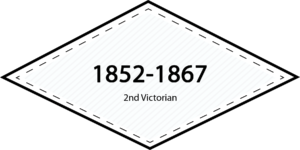
“Pre-Raphaelites & Crinolines”
Ready-made rules from mourning to evening
—— ERA IN BRIEF ——
“Ready-made” meant mass produced garments & mass promoted rules made by Queen Victoria of England to tell every day people what to wear from night to mourning. Huge crinolines & hoops swept along tree-lined boulevards & boardwalks of beautiful Paris while the “Aesthetics” & “Artists” wore gowns you could sweep in.
 —— PORTRAITS OF REAL WOMEN FROM THE ERA ——
—— PORTRAITS OF REAL WOMEN FROM THE ERA ——
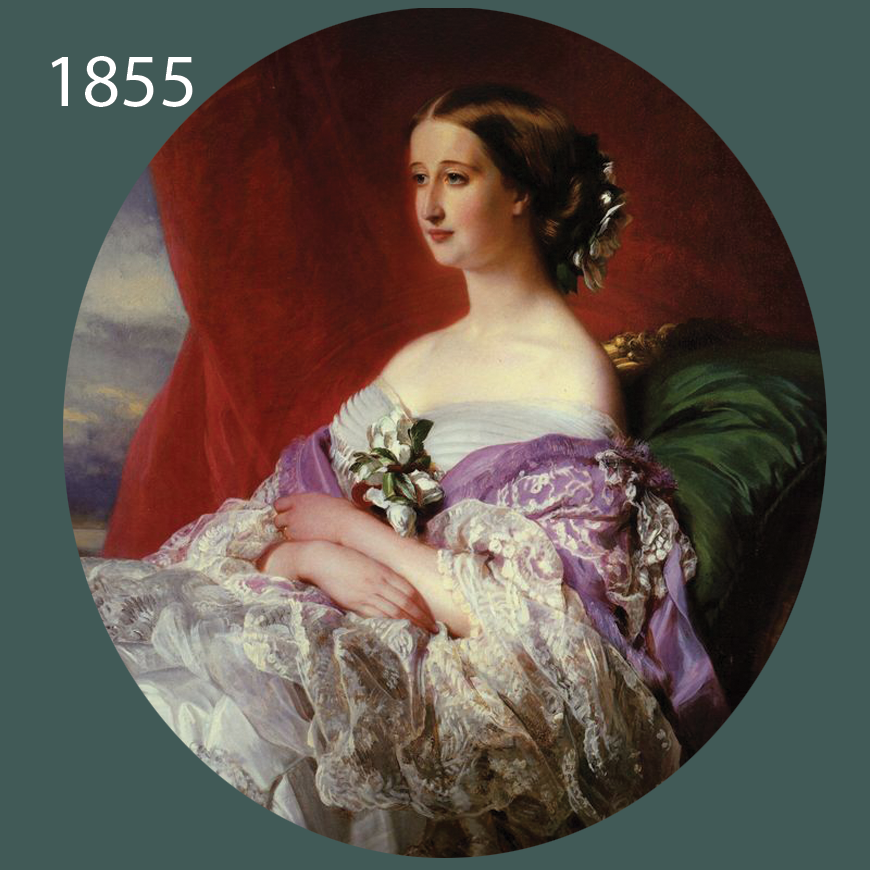
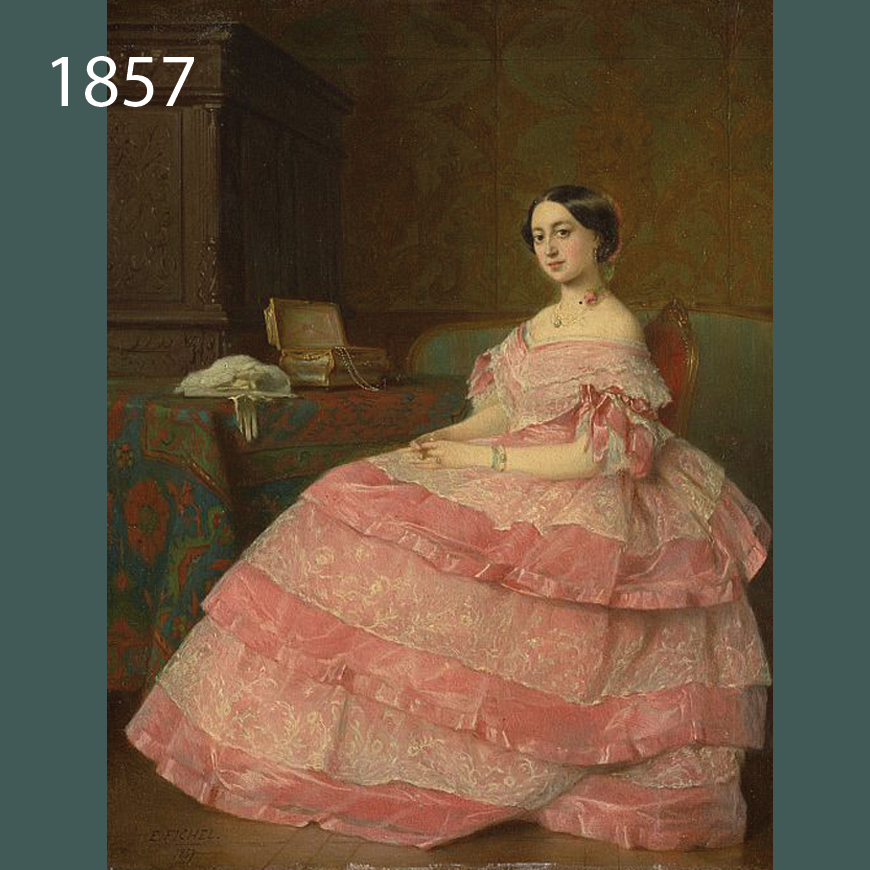
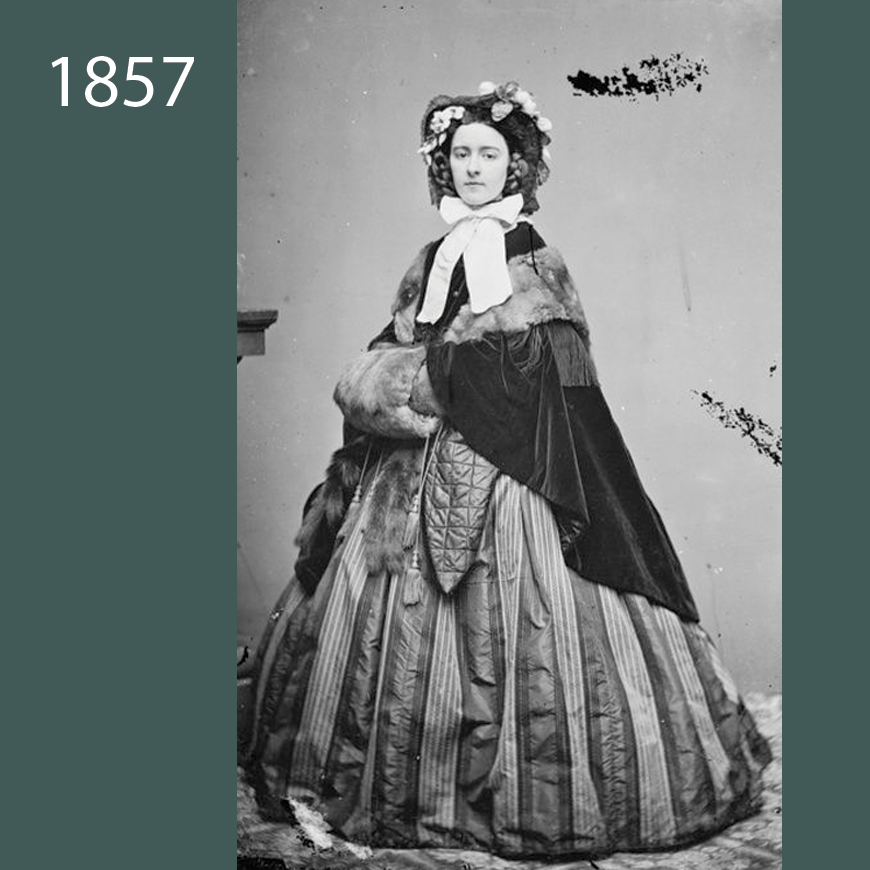
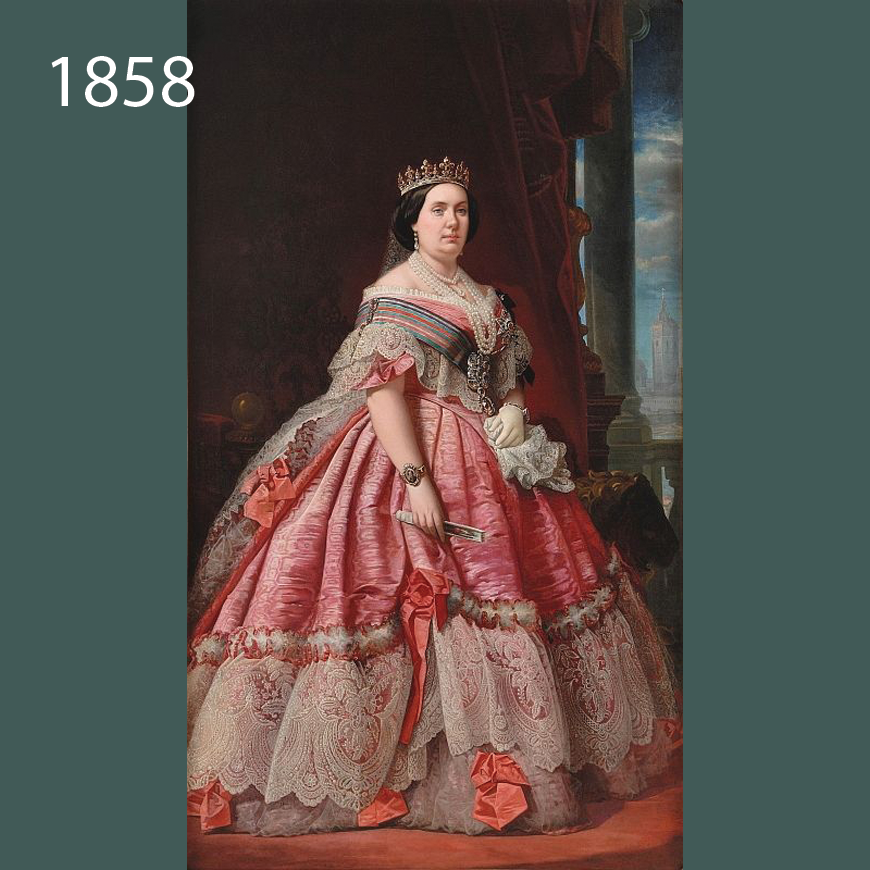
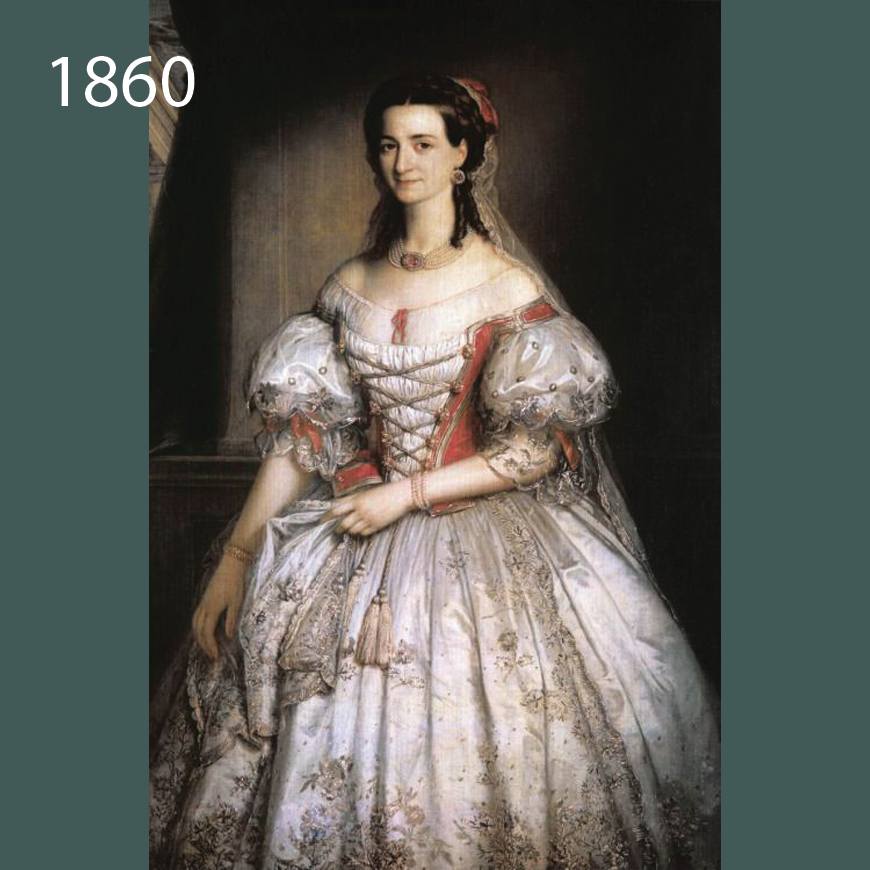
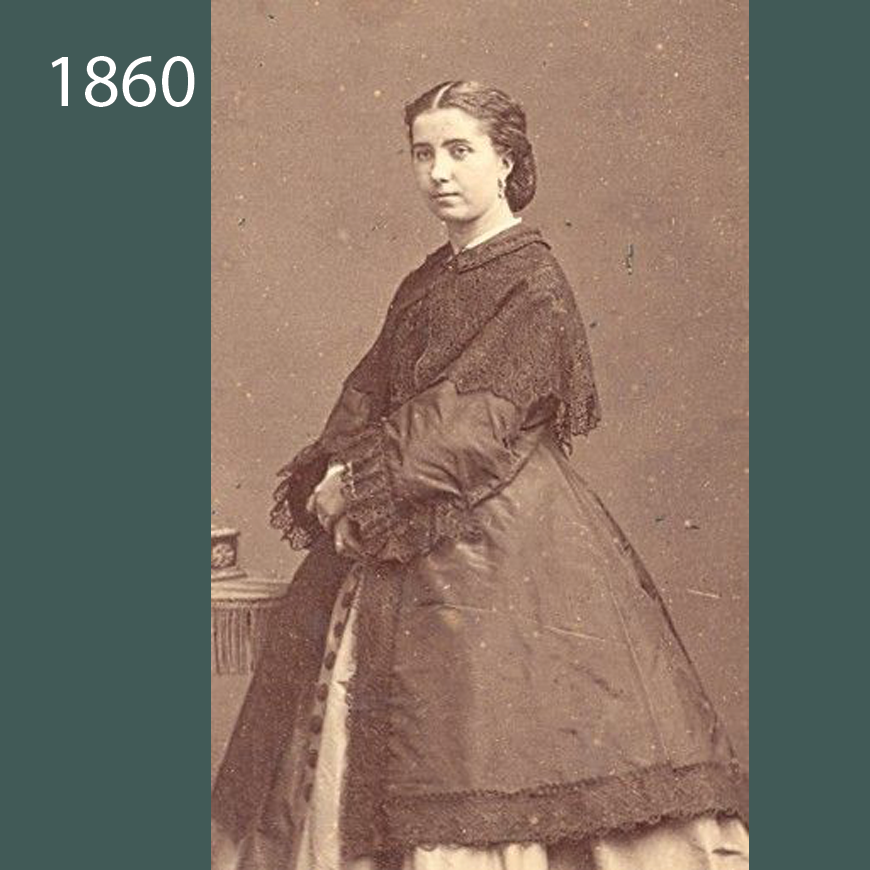
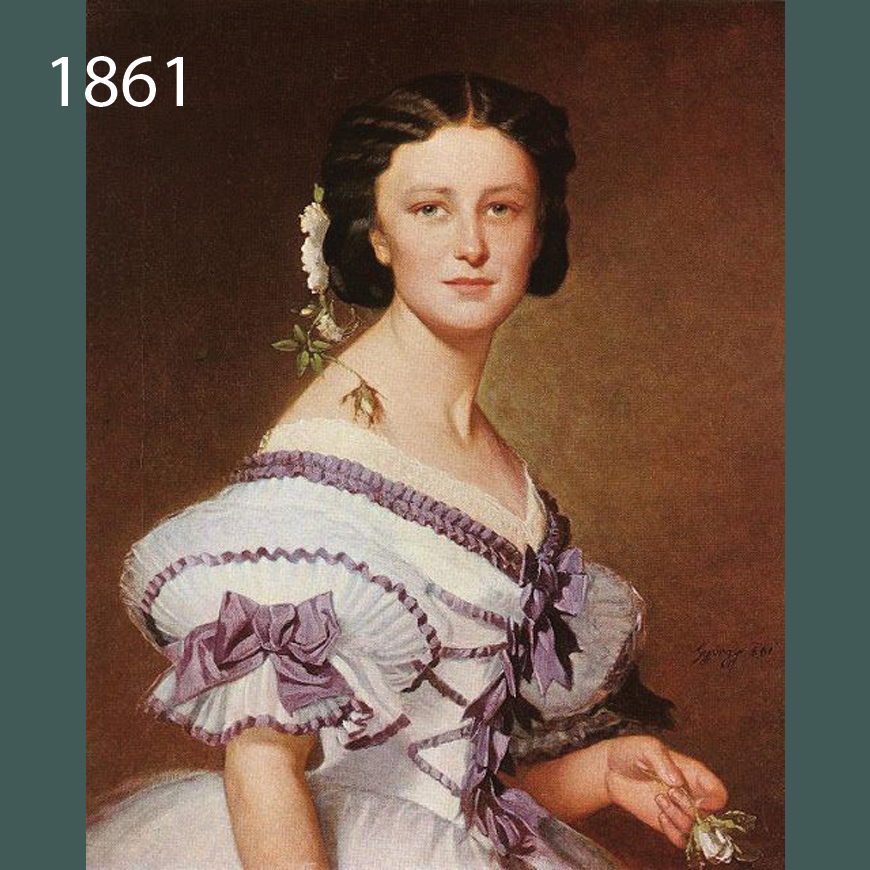
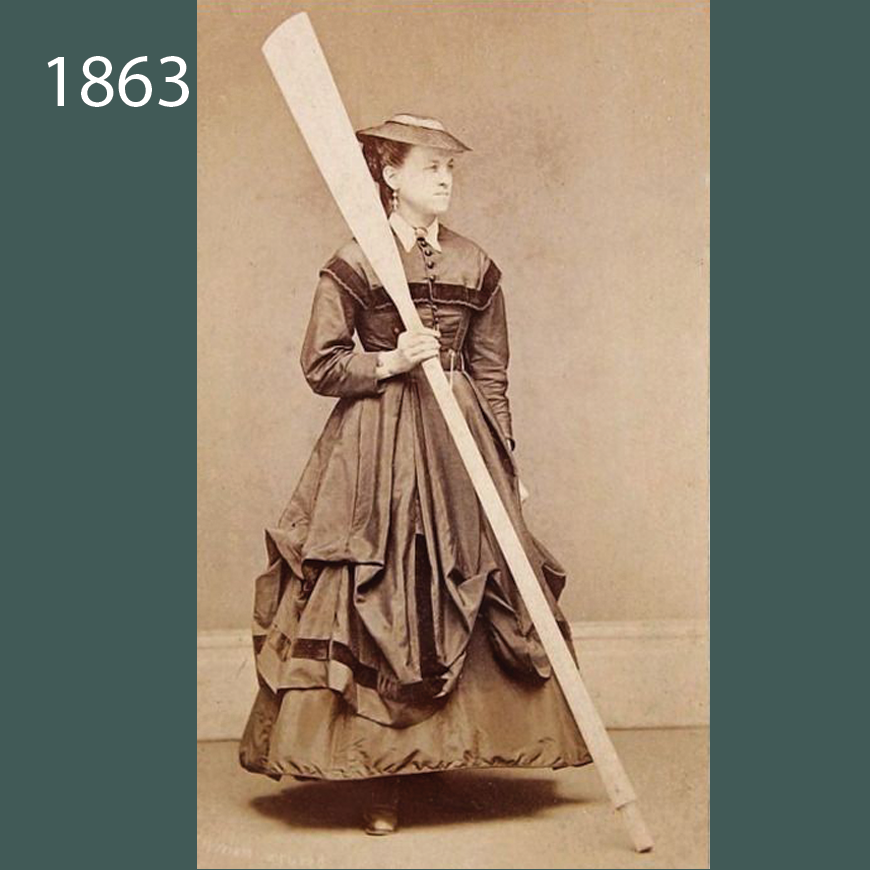
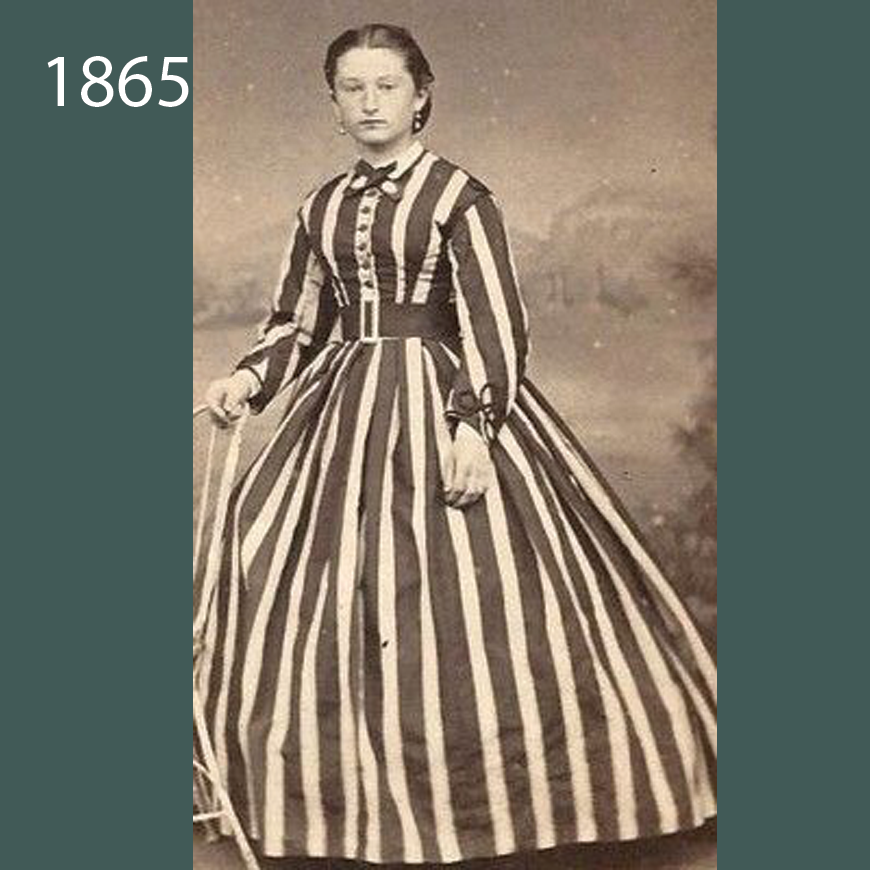
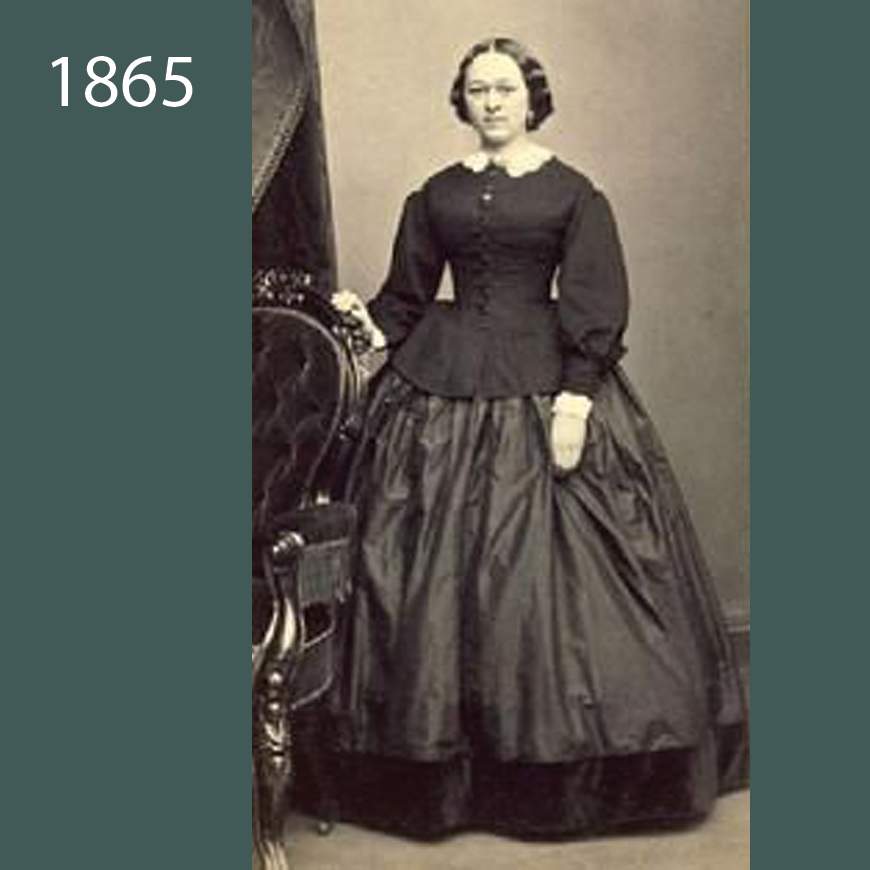
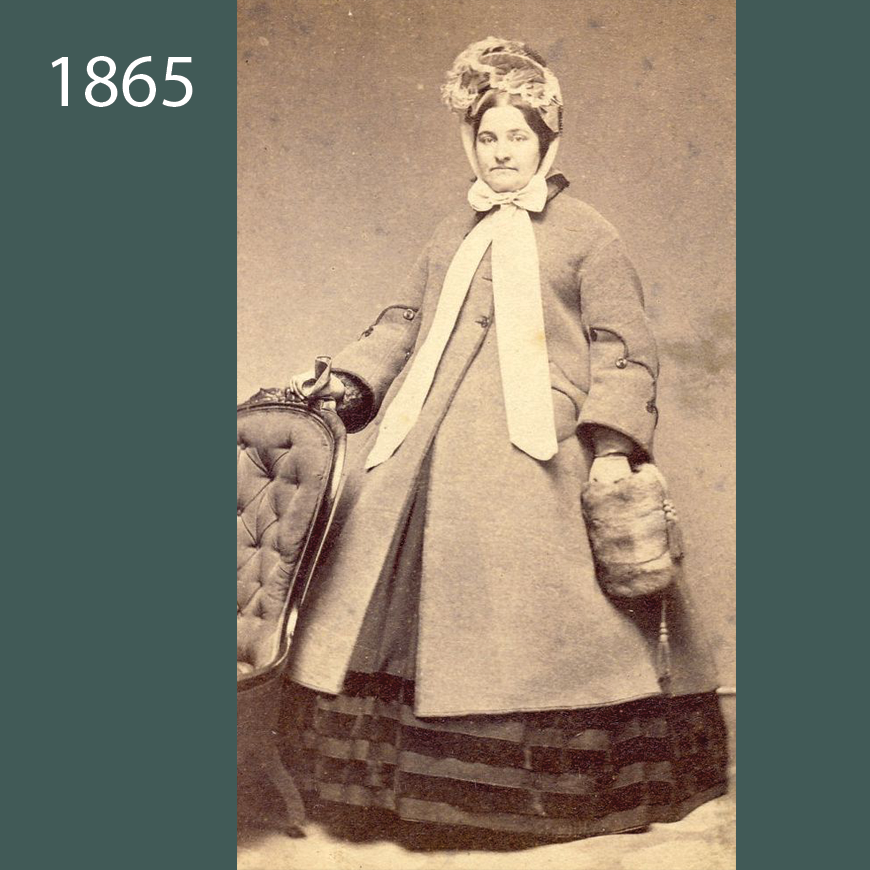

—— WORLD SITUATION ——
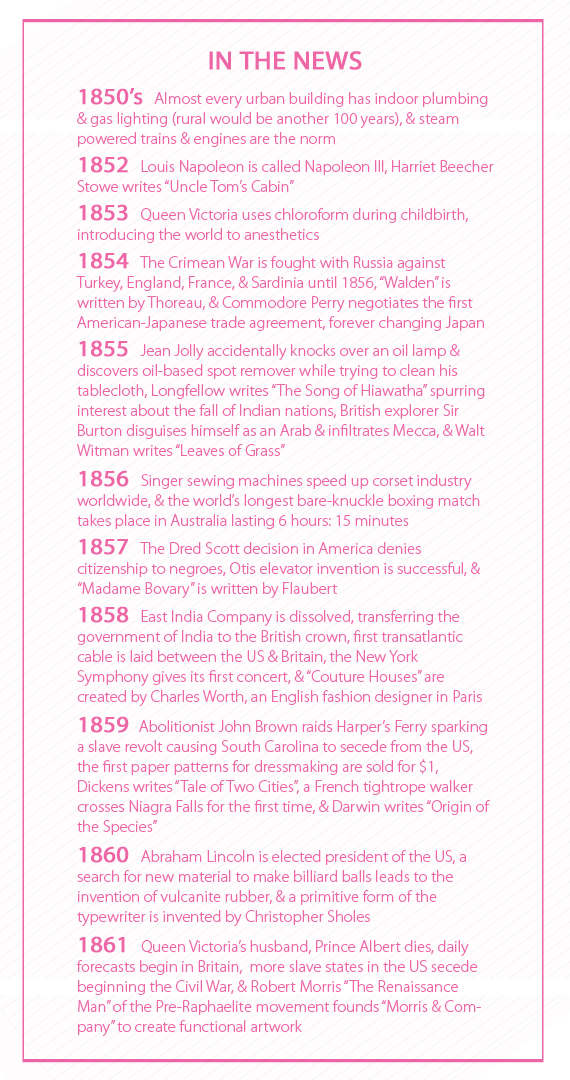
- The British were defeated in the New Zealand Wars
- The Geneva Convention met to establish rules of warfare
- Louis Napoleon, younger brother of Napoleon I, called himself Napoleon III in establishing the 2nd Empire of France in 1852
- 1852-1870 under Napoleon III was a prosperous time in France where quick fortunes were made & there was much consumerism
- Paris was transformed by the rich into a world renowned beautiful city with its tree lined boulevards, paved streets, street lights, theaters, operas, & upscale department stores
- The Crimean War of 1854-56 pit Russia against Turkey, England, France, & Sardinia
- Science continued to advance with a new under Atlantic communication cable
- Pasteurization was a breakthrough for medical science
- America went through Civil War from 1861-1865; ending with the 13th amendment to abolish slavery & Lincoln’s death
- America had uniforms mass produced during the War
- An American steamboat exploded, killing Union soldiers heading for home after the war, & the Homestead Act was issued to settle the West
- The Indian Wars in western US were ended by treaty with the Shoshone who agreed to “stop harassing immigrant trains”
- In America, Thanksgiving was created, the Secret Service was organized, & Alaska was purchased
- American paper currency “greenbacks” were made for the first time
- 1865 was a year of “Yellow Journalism” when William Hearst, editor of a San Francisco newspaper intentionally created “fake news” in false sensational headlines by reporting interviews that never happened, & publishing huge graphic photos promoting the side of whomever Hearst believed to be the “underdog”
- Ready-made & department stores were doing huge business in Europe & the United States
- Catalog sales for nearly anything a person could need were booming, especially in remote & western US regions
- Brigham Young had one of the most prosperous department stores in Salt Lake City, UT
- Riding a horse was a favorite way for men & women to escape norms & expectations of society for all classes
- The horse was also a favorite to race, breed, or gamble on
- Football in England was split between rugby & soccer
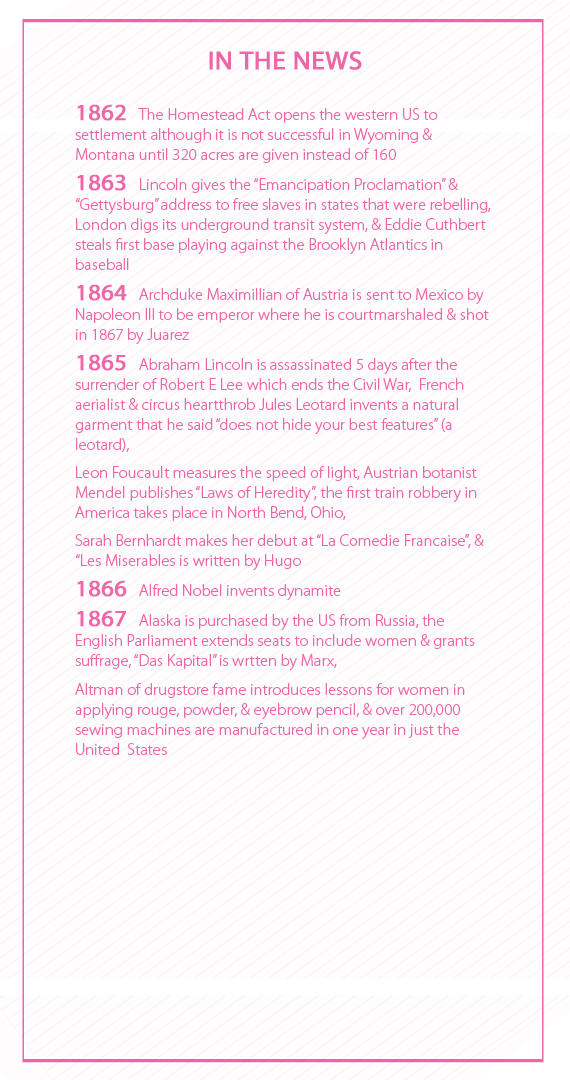
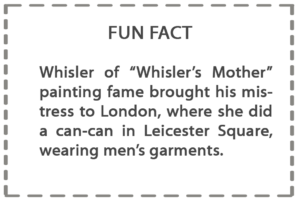
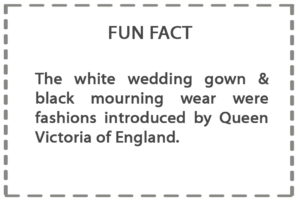

—— INTERESTING FACTS ——
ODD ENDS
- There were successful & not so successful innovations in this era that affected the fashion industry
GOOD
- Mauveline Aniline dyes, the first chemical dyes, were discovered in 1856
- The first synthetic dyes were mauve & bright purple
- In 1860 two bright pink dyes were named for battles in Italy’s fight for independence: magenta & solferino
- Polka dots were invented in 1855
- Singer put the first sewing machine to practical use in 1861 when he sold them to a corset manufacturer
- In 1856, Singers were used for stitching boning to corsets, which were being mass produced with great variety
- Singer opened multiple shops to sell his machines at retail
- For this, Singer is credited with having the first multiple shop trading in history
- A cutting process further improved mass production
- Once both cutting & sewing became mechanical, production increased rapidly.
- People did piece work in their cottages in the country
- There was a complex distribution system in the city to get the pieces from cottages to the assembly factories
- The first paper pattern was sold in 1859, though not yet in standardized sizes which would come later
- Patterns were available to the general public
- Used clothing was a big business, with whole districts devoted to it
- Used clothing was sold on the street from peddler carts. Peddlers did a very lucrative business
- Levi Strauss invented denim jeans in this time in response to a miner’s complaint that they had nothing durable to wear
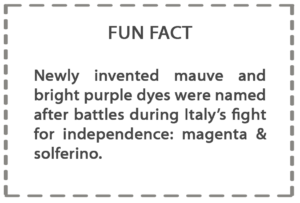
QUESTIONABLE
- Whisler of “Whisler’s Mother” painting fame, brought his mistress to England where she did the can-can in Leister square, wearing men’s clothes so as to not start a riot
- Florence Nightingale put mass production to a test when she organized 38 nurses to go to the Crimean War. Her demand for “grey tweed wrappers”, worsted jackets, caps, & brown scarves with “Scutari Hospital” emblazoned in red was met in only 4 days
- Unfortunately none of the Nightingale uniforms fit
- Fashions adopted more slowly in America than in Europe because fashion plates would appear in American magazines as much as a year after they were published in Paris or London
BAD
- Corsets were extremely constricting & uncomfortable. There was huge controversy about the dangers to women’s health due to corsets
- New dyes were poisonous & highly flammable
- Crinolines could also easily burst into flame
- The Victorians suffered for their brilliant arsenic gowns & shoes, & flammable crinolines
- The green of the shimmering silk was one of the mid-Victorian era’s favorite colors & the most deadly
- Starting out a vivid hue made from natural dyes, green was now fashionably pale & made of an arsenic-based dye
- Despite full public knowledge that wearing green could lead to a horribly painful & early death, women still wore it because it was fashionable
- The prime risk was for the wearer, who would sweat & absorb the poison through their pores
- Dangers of the dye didn’t end with just wearing it. A long chain of people from factory workers to seamstresses to fellow ball-goers who brushed against the gown were in danger of arsenic poisoning
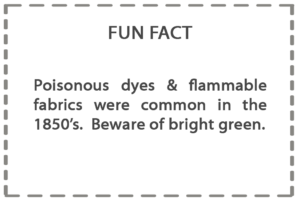

—— FASHION TRENDS ——
VICTORIANS
- Women progressed further in their independence
- They started to exercise publically, although they still didn’t work (except to run farms, plantations, & their husband’s or father’s businesses)
- The death of England’s Queen Victoria’s beloved Albert, intensified her intent that “appropriate” dress be worn for all occasions
- Victoria introduced the black mourning ensemble & protocol of mourning
- The white wedding gown was also invented by Queen Victoria at this time
- Victorian rules applied more than ever to all aspects of living, with strict rules of decorum & appropriate apparel for each given situation
- Victoria’s rules applied to all classes & types of women
- Except for French “Haute Couture”, women of other countries including France, were following English fashion, & therefore Victoria’s mandates
- Victoria hosted 3 balls a year plus other events to give the populace a chance to see how fashion concepts were applied
- Under the influence of French Designer Worth & Queen Victoria, the fashionable “costume” of the era included chemise, split pantaloons, petticoat(s), crinoline, bodice, skirt, & accessories
- A typical Victorian dress might weigh 7 pounds, but with all the understructures & additions, a woman carried an average of 20 pounds per garment, & 30 pounds per ensemble
- Approaching 1860 when the style peaked, fashion dictated a woman needed to have WIDE hips, but not just wide, up to 18 feet wide
- These feats of fashion were achieved using voluminous skirts & petticoats with crinolines or hoops
- The form & function of the crinoline was similar to the 16th & 17th century farthingale in achieving the extremely wide silhouette
- The word crinoline & hoop were used interchangeably to describe any of the dome or bell shaped undergarment structures of the eras 1840-1870
- “Crinoline” loosely translated meant “stiff horsehair”
- In the 1850’s, crinolines & hoops were huge structures shaped & wired using horsehair & linen, so as to extend the skirt even further than the large bell shape of the 1840’s
- Steel cage crinolines were patented in 1856 by a Parisien, & marketed with great success to England (& then America) through an agent
- Steel crinolines were mass-produced in huge quantities; factories produced over 10,000/year
- Alternative materials such as whalebone & caoutchouc (natural rubber) were used for hoops, although steel was the most popular
- The “American Cage”, an American manufactured type of hooped petticoat partially covered in fabric, came in bright colors made possible by the new aniline dyes
- By 1857-58, the cage crinoline or hoop had reached maximum size, popularity, & usage
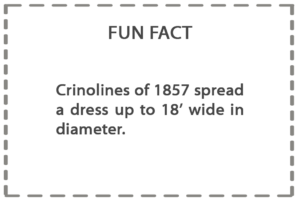
- Women were delighted to wear the cage as it provided relief from the weight of numerous petticoats of prior eras
- They liked that a hoop didn’t have to be washed like the many layers of undergarments required to get the look previously
- The hoop was worn almost universally & could be seen on ladies, maids, the middle class & shop girls
- Women working hard in fields & those scrubbing floors were some of the few exceptions. These workers still wore layers of undergarments instead of hoops
- When at its widest point in history, a crinoline could have a circumference of 6 yards, requiring the wearer to get assistance from a person and/or cantilever device to get into it
- The cantilevers were much like small scale cranes used a shipping wharf to swing loads onto ships
- Use of a huge, cumbersome crinoline defined class structure, as it was necessary to have a servant or slave to assist, especially with the largest hooped garments that were worn for evening
- Large crinolines & hoops, however, had many disadvantages which led to their demise by 1860
- Crinolines were so huge a woman could not get in doors or carriages
- Only 3 women could be in a typical room at one time
- While reticulating, folding, & collapsing forms were developed, women still had trouble sitting down, climbing, or doing anything
- Women of the era were becoming increasingly physically active as the 1870’s approached, & needed functional clothing
- Fashion of the crinoline era was definitely not for the physically active
- For reasons of influence from the counter “Aesthetic” & “Artistic” movements, social statements & influence by key figures, marketing, & plain practicality, the crinoline saw its end by 1868
- The period 1860-1882, following the decline of the crinoline, was known as the “First Bustle Era”. Women would not entirely sacrifice fashion for the ability to move even then however, as the fully spherical round domes did not disappear, but changed to back extension structures
- The round hoop of 1860 evolved into an oval hoop by 1864, which would lead to the back bustle of 1868
- Between the crinoline & bustle was a hybrid called a “crinolette”. This was a cage structure attached around the waist, which extended down to the ground, but only went down the back of the legs to the knees
- The main purpose for the crinolette was to keep the fabric off the back of the knees so the woman could walk
- The crinolette was quickly replaced by the true bustle which could support heavy drapery at the back of the skirt while keeping the fabric away from the knees
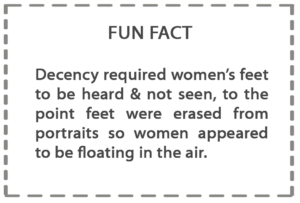
ANTI-VICTORIANS
“PRE-RAPHAELITE”
- The “Pre-Raphaelite” Brotherhood was organized to counter Victoria’s restrictive art & fashion of the day
- The “Pre-Raphaelite” movement was the desire to return to quality & craftsmanship
- “Pre-Raphaelites” felt mass production had changed the world of manufacturing forever in a way so that quality & craftsmanship could never return without a radical movement
- They called themselves “Pre-Raphael”, because they believed the artist Raphael began a point from which art needed to turn
- They wanted to reform art by subjecting it to a mechanical approach
- “Pre-Raphaelite’s” own art was based on medieval models, had extreme attention to detail, rich color, & pictorial content
- “Pre-Raphaelite” themes were somewhat erotic, as women were depicted as if appearing in dreams in lush settings & flowing robes
- Their art produced a moody, penumbrial atmosphere
- At this time & into the next century, “art” was considered not just painting, sculpture, or what we would call “fine arts”
- Art of the time included textiles, garments, furnishings, & decorations: anything that was crafted with visual 2 or 3 dimensional form
- The “Pre-Raphelites” were best known for their 2-dimensional paintings, but they affected all the other art forms of the time, & were the basis for other movements to come
- “Pre-Raphaelites” particularly influenced textile & garment industries
- There were 2 “Pre-Raphaelite” movements
- The 1st movement had little effect on art, fashion, or society, as it was somewhat of an “underground” movement that was considered only valuable in intellectual or artistic communities
- The 1st movement was focused primarily on painting, although the basis for clothing design was established by its leaders dressing up their wives in their concept of “anti-Victorian” fashion
- 1855 was considered the beginning of the 2nd movement
- The 2nd movement impacted the everyday person because it was more grounded & understandable
- Crafstmanship adhered to the use of natural products such as real wood instead of veneer
- To the uneducated, “Pre-Raphaelite” looked like quality produced goods in a time of mass production was considered to be of poor quality
- The “Pre-Raphaelites” actually had an underlying philosophy that people of the time didn’t understand
- “Pre-Raphelite” meant that design & construction should be based on the “Truth” of materials or forms
- The 2nd “Pre-Raphaelite” movement would branch into the “Arts & Crafts” movement in about 1900
- “Arts & Crafts” would be similar to “Pre-Raphaelite” in that it would guide artisans & craftsmen to attain the same rich, colorful, pictorial art through the use of natural forms & natural materials
- “Arts & Crafts” would be different in that it would not have the philosophical bases or conceptual return to the medieval model. It was more of a high quality craftsmanship visual art form
- “Arts & Crafts” would lead to “Art Nouveau”, which would evolve into “Art Deco” in the 1920’s (discussed in the “Art Nouveau” section)
AESTHETIC
- 1860’s mainstream fashion was characterized by the extremely full-skirted fashions relying on tight lacing corsets, crinolines, & hoops
- This style was contradicted by the emergence of “alternative fashions” under the influence of the “Artistic Dress Movement” spearheaded by the “Pre-Raphaelite Brotherhood”
- The “Aesthetic” movement was a type of subversion from the values at the time
- “Aesthetics” symbolized women’s rights through a freer lifestyle
- Having only natural decoration, the “Pre-Raphaelite””Aesthetic” fashion was a part of the “Arts & Crafts” movement
- “Aesthetic” was believed to be “healthier” for the “new woman” of the day
- “Aesthetics” objected to the elaborately trimmed high fashion of those following Victorian dictates & its emphasis on rigid corsets
- “Aesthetics” believed corsets & hoops were ugly & dishonest
- The “Pre-Raphaelite””Aesthetic” movement removed corsets & all structural undergarments from fashion entirely
- Based on garments of working women, “Aesthetic” gowns had no collar & no structures
- “Aesthetic” gowns had only 1 chemise & 1 petticoat – or nothing at all – beneath the gown
ARTISTIC
- “Artistic Dress” was a different “anti-fashion” movement from 1850-1900 that rejected highly structured & heavily trimmed Victorian trends in favor of beautiful, natural materials & simplicity of design
- “Artistic Dress” had specific sub-categories by region including “Aesthetic Dress” & “Kunstlekleid”. These 3 terms are used interchangeably to indicate the style form, although they are different in concept & philosophy
- The main difference between “Aesthetic” & “Artistic” is that “Aestheticism”(like “Pre-Raphaelism”) was a philosophy based on finding the “Truth” in an object
- “Artistic”, like the “Arts & Craftsman” movement was born out of “Aesthetics” & “Pre-Raphaelites”
- “Artistic” refers to high quality craftsmanship with highest visual quality (the “aesthetics” of a piece) rather than a philosophy or belief
- “Artistic” dress also had influence in social behavior in the attempt to merge class distinction
- Upper class “Artistic” women were encouraged to behave like lower class women when they dressed like them
- “Artistic” gowns had loose waistlines & were made of flowing fabrics
- They had simple shapes
- “Artistic Dresses” were loosely fitted & comparatively plain, often with long puffed or long, juliette sleeves
- They were made from fabric in muted colors derived from natural dyes
- They could be ornamented with embroidery in the art needlework style
- Fabrics used in America for “Artistic Dress” were silk, velvet, muslin, or fine lawn
- The style was characterized by medieval design, narrow skirts, & hand embroidery
- “Artistic Dress” was popular in intellectual circles & among artists for its natural beauty
- It reinforced the social ideals of artists of using quality material, having respect for work of the hands, & a purity of medieval design
- Both “Aesthetic” & “Artistic Dress” movements were largely in response to the mass production & mechanization of the textile & garment industries
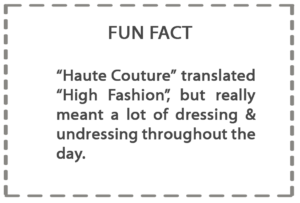
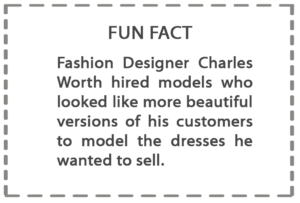
“HAUTE COUTURE” (“HIGH FASHION”)
WORTH, POOLE, & EMPRESS EUGENIE
- Nearly polar opposite of the “Pre-Raphaelite” movement were two Englishmen: dressmaker Charles Worth, & tailor Henry Poole
- Worth & Poole introduced designer labels to the fashion world
- They put French labels into English made garments & marketed them as having come from the high fashion centers of Paris
- Both men were extremely successful, & moved operations to become world renowned French designers
- Poole’s impeccable manners & the wisdom to extend limitless credit to customers, made their shops on Paris’ Savile Row fashion district synonymous with elegance.
- A Savile custom tailored suit would have extra buttons, flashy lapels, & trousers cut high at the waist as marks of quality
- Worth developed the “Haute Couture” movement where every activity required a specific “costume”
- Consistent with Victoria’s ruling that clothing should be appropriate to the activity, Worth’s “costumes” took the idea a bit further by dictating just what those ensembles should be
- He became the leader of fashion worldwide due to innovative ideas in design & excellent marketing & sales ability
- A large part of Worth’s success were (besides his ego) his “doubles”; live women models who were selected because they looked like beautiful versions of Worth’s clients
- Worth also invented the concept of subtle, flattering lighting in his salon
- Charles made satin popular again
- He introduced the tailored suit which had skirt & jacket in same fabric
- Empress Eugenie, the new, young, & stylish wife of the latest Napoleon of France, was Worth’s best customer. She had him design almost everything for her using purple
- As a fashion leader, Eugenie’s open love for the crinoline was a large reason for its popularity. She brought the crinoline to favor in the English court on visits to Queen Victoria
- Following Worth’s tutelage, she was also a major reason for the crinoline’s decline in popularity when Worth decided the fashion world needed to get rid of the crinoline, & advised Eugenie that it was now out of style
- Worth, with Eugenie’s worldwide influence, got women to throw away crinolines by designing & heavily marketing a “crinolineless dress” that was gathered in the back
- Boasting that he had “dethroned the crinoline”, Worth was credited with introducing the “first bustle” of the next fashion era
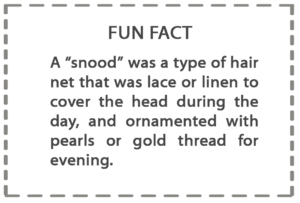

—— SPECIFIC FASHIONS ——
SKIRTS
- Skirts of the 1850’s-60’s were assembled of shaped panels since gathering a straight length of fabric could not provide the hem circumference without unwanted bulk at the waist
- This ended the brief demand for dresses with a border printed around the hem, because it was difficult to print a repeating pattern on a paneled skirt
- By the early 1860’s, skirts had reached their ultimate width
- As time went on, the huge bouffant gowns with the largest crinolines were reserved only for special occasions
- Sleeves narrowed, & the hoops decreased in size at the front & sides, & increased at the back
- After 1862’s huge bell-shape, the silhouette became flatter at the front & projected out more behind
- This large back area was decorated by puffs, strips, flounces, lace, gold & silver embroidery & so many embellishments, it was hard to see the skirt fabric
- Looped up overskirts revealed matching or contrasting underskirts; a look that would reach its ultimate expression in the next 20 years of the bustle
BODICES, NECKLINES & SLEEVES
- A skirt might be made with two bodices that could be “swapped out”: one long-sleeved & high necked for afternoon, & one short-sleeved & low-necked for evening
- Bodices were well fitted & pieced like the skirt to minimize bulk around the waist
- Waistlines rose briefly at the end of 1850
- By the 1860’s, the bodice waist became slightly shorter, but the dropped shoulders remained
- Square yoke lines were often worn for day
- High necklines with lace or tatted collars or chemisettes covering the bare skin of the square yoke completed a demure daytime look
- Square yokes were also created with braid, fringe, or developed as a separate piece that could be removed for evening wear, leaving the lower, square neckline
- To emphasize the wide neckline on evening dresses, “Bertha” collars were worn; a style which carried through from the past era
- “Berthas” followed the line of the decollete, & were made of pleated fabric, ruffles, or lace
- Evening gowns had low necklines & short sleeves, & were worn with short gloves or lace-crocheted fingerless mitts
- Day dresses featured wide pagoda sleeves worn over under sleeves or “engageantes”
- Sleeves narrowed & although fitted at the wrist, had a little width at the elbow
UNDERGARMENTS
- A chemise was worn under the corset. It was short sleeved, knee length, & made of linen or light cotton
- Flat lace, silk ribbon, & inserts were used for decoration
- Some flat embroidery was used, but only if it was flat enough not to show through the bodice
- Lace & ruffles were common on the bottom of the chemise
- Chemise & stockings worn were meant to soak up perspiration & protect outer clothing
- Pantaloons were worn in this era. These would have a flat panel which would button at the sides & a split crotch
- Ruffles & lace with ribbon ties were common at the bottom of the pantaloons to tie the pant leg below the knee
- Some pantaloons did not tie at the bottom
- Due to the many layers of dress, elite class women of southern climates took naps to rest from wearing their large dress & constraining corsets
- Petticoats, under some disuse because the crinolines kept the dress shape, returned as the silhouette changed to have the fullness in the back leading up to the bustle
- Petticoats were made of white muslin with some ruffle, & were paneled similar to the skirt
- Only one petticoat might be worn over the crinoline as a cover, with one underneath, although additional petticoats were worn depending on the situation for modesty or warmth
- The shape of the petticoat followed the shape of the skirt until it too had fullness only in the back with a flat front & multiple layers of ruffles along the bottom
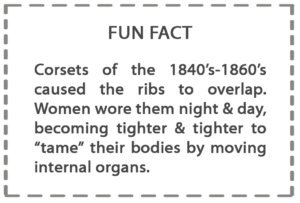
CORSETS
- As skirts became narrower & flatter in front, more emphasis was placed on the waist & hips
- Corsets were absolutely required for fashion as women attempted the objective of an 18″ waist
- Corsets were a distinguishing fashion of this era, as they were used to shape the body to extremes
- The corset was used to mold the body to the desired shape
- This was achieved by making corsets longer than before
- Corsets were constructed from separate shaped pieces of fabric
- To increase rigidity, they were reinforced with many strips of whalebone, cording, or pieces of leather
- The heavy structure kept them from riding up or wrinkling at the waist
- Steam molding also helped create a curvaceous contour
- Developed in the late 1860’s, the steam mold procedure placed a corset that was wet with starch on to a steam heated copper torso form until it dried into the desired shape
- Corsets caused the ribs to overlap, & were extremely painful
- Women wore them to gradually “tame” their bodies, which really meant moving internal organs
- There were corsets for day, & others for night, but women wore them all the time
- Night corsets were somewhat looser, but still kept the body molded into shape
- Girls & children wore versions of corsets to prepare them for adult corsets
- A major problem with corsets of this era, was that when a woman would remove them to have a child or for any reason, the quick movement of organs back to normal position became deadly
- Many women of this era died in childbirth due to the rearranged body structure being altered
- Doctors tried to get women to stop wearing them, but fashion won every time
- Tight lacing & forming the body using corsets continued to be hotly debated topic until their end prior to WWI
FABRIC & TRIM
- Braid & lace were in their element as the most popular & widely used ever at this time
- Fabric remained lightweight in general with lawn, & taffeta
- Silk & wool blends were most popular for dresses
- Dresses tended to be made of one fabric with lace or trim added for interest
- Heavy silks in solid colors were fashionable for both evening & day wear
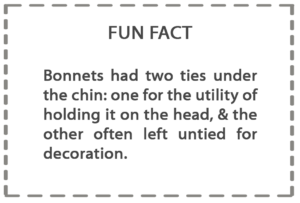
HEADWEAR
- Hair was worn parted in the middle & smoothed, waved, or poofed over the ears in front
- The back of the hair was braided, & the braided section was turned up & pinned into a roll or low bun at the back of the neck
- Hair styling was maintained by the use of hair oils & pomades
- Styled hair was confined to decorative hairnets
- Hairnets are referred to as “snoods” today, but that is not what they were called then. They were called hair nets
- Hairnets were especially worn by younger women
- They were made of very fine material to match the wearer’s hair color for regular, daily wear
- More elaborate versions were made of thin strips of velvet or chenille & decorated with beads
- Many hairnets were decorated on the edge with ruchings of ribbon
- Bonnets for outdoor wear had small brims that revealed the face
- Earlier bonnets had lower brims
- By the 1850’s, Spoon Bonnets, which featured increasingly high brims & elaborate trimmings were the vogue
- Bonnets were made specifically to accessorize a dress
- Bonnets could be made of a variety of materials
- Buckram & wire covered with fashion fabric was very popular
- Warm season bonnets made of straw, woven horsehair, or gathered net were favorites
- Winter saw heavier materials like velvet, though most women wore quilted hoods in winter instead of bonnets
- Bonnet trim varied according to changing style, but all had a similar form
- Rows of gathered net lined the brim. This was a carryover of the 1840’s
- A decorative curtain “bavolet” shaded the neck in the back of the bonnet
- Another standard for all 1860’s bonnets were ties. There were two sets; utility ties to take the strain of tying, & another set of fancy material
- The rich, beautiful strings were tied below the chin in a huge bow, or left untied to show off the fabric
- Bonnets fell out of fashion by 1870 in favor of small hats
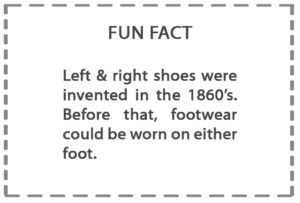
OUTERWEAR
- Cloaks & mantlelets remained fashionable for practical reasons that they were the only outerwear capable of covering the huge triangular silhouette & bell shaped skirt
- Shawls worked wonderfully as they could spread out over the width of the hoop
- Shawls were popular for their ornamental possibilities as well as their functional role
- Shawls folded on the diagonal of the fabric to make a triangle
- Short capes or cloaks which reached just to the fullness of the top of the skirt were worn
- There were fitted riding jackets with split seams at the bottom to fit over the wide skirt
- Long coats were abandoned except for dusters in favor of fitted or unfitted hip-length or knee-length jackets
- Dusters were long coats made of linen to protect from dust. These would never be made of silk or other fine materials
- 3/4 length capes were worn; some with & some without sleeves
- For walking, jackets were accompanied by floor length skirts that could be looped or drawn up by means of tapes over a shorter petticoat
- The Garibaldi shirt, named after an Italian revolutionary, was popularized by Empress Eugenie of France. It was a bright red woolen garment featuring black embroidery & braid with military details
- America saw increased popularity of military-influenced styles such as the Zouave jacket
- The Garibaldi & Zouave were worn over a “waist” (blouse) or chemisette (front insert appearing to be a blouse), & skirt with a belt at the natural waistline
FOOTWEAR
- Decency required a lady’s feet be heard and not seen, to the point feet were erased from portraits so women appear to be floating in air in photographs and portraits
- Left & right shoes were invented. Prior to this, all footwear could be worn on either foot
- Shoes were impossibly narrow & painful
- The licentious woman came of great interest in this era. Boudoir shoes became of interest for “non-prurient pursuits”
- Mules, a type of boudoir slipper were favorites to highlight femininity
- “Destabilizing heels” on a high heeled boot were a danger of the time
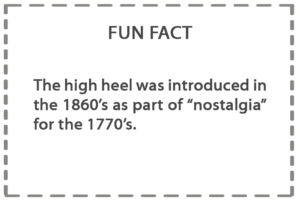

—— ACTUAL GARMENTS FROM THE ERA ——
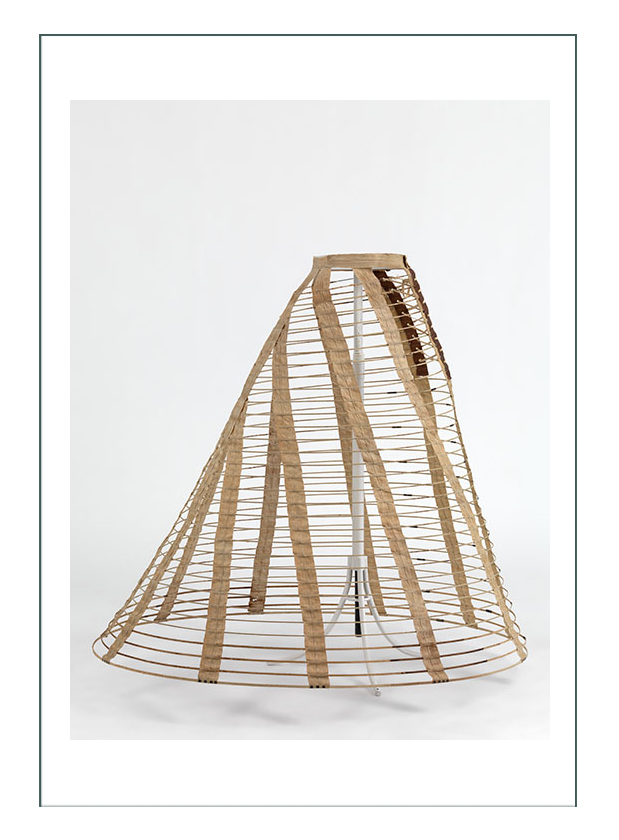
—— (above) “Crinoline Cage 1850-60’s” ——
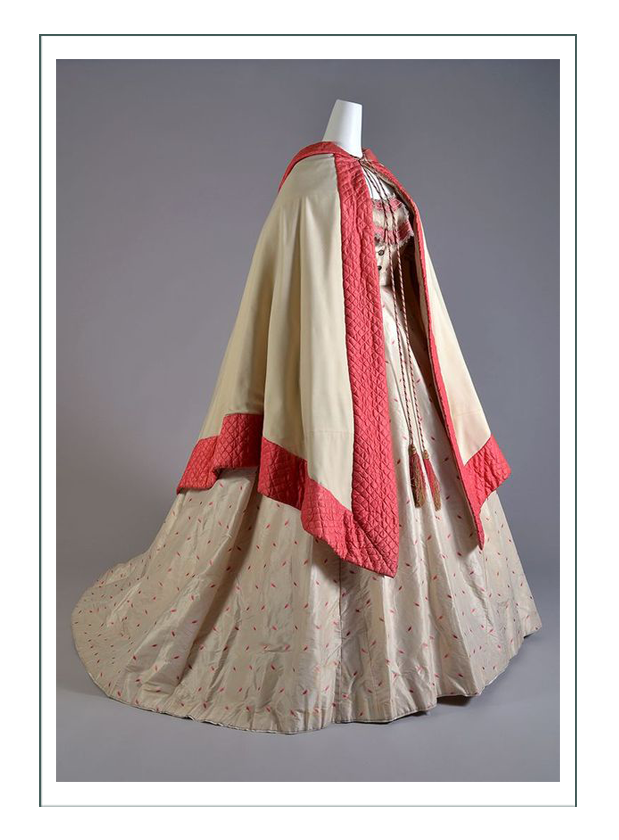 —– (above) “Burnous Cloak 1852” —–
—– (above) “Burnous Cloak 1852” —–
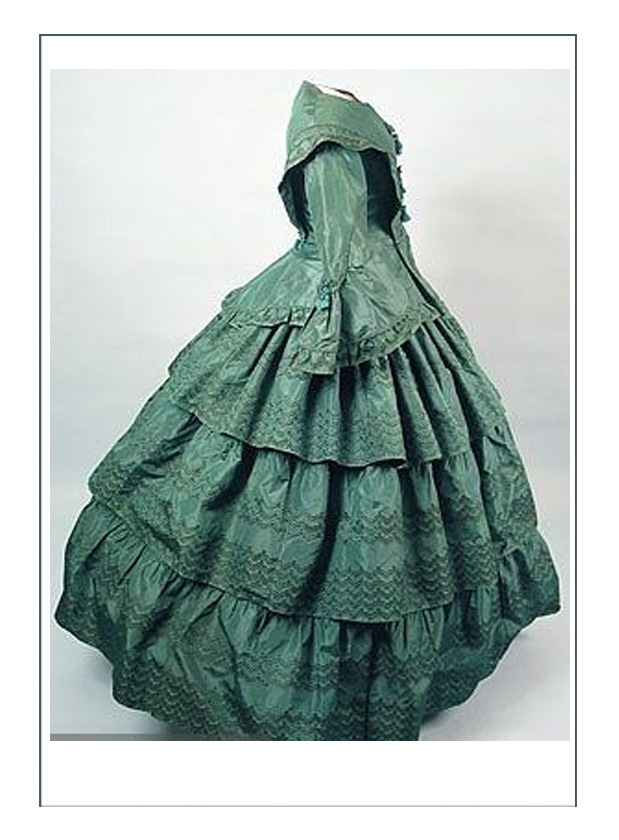
—— (above) “Taffeta Day Dress 1855” ——
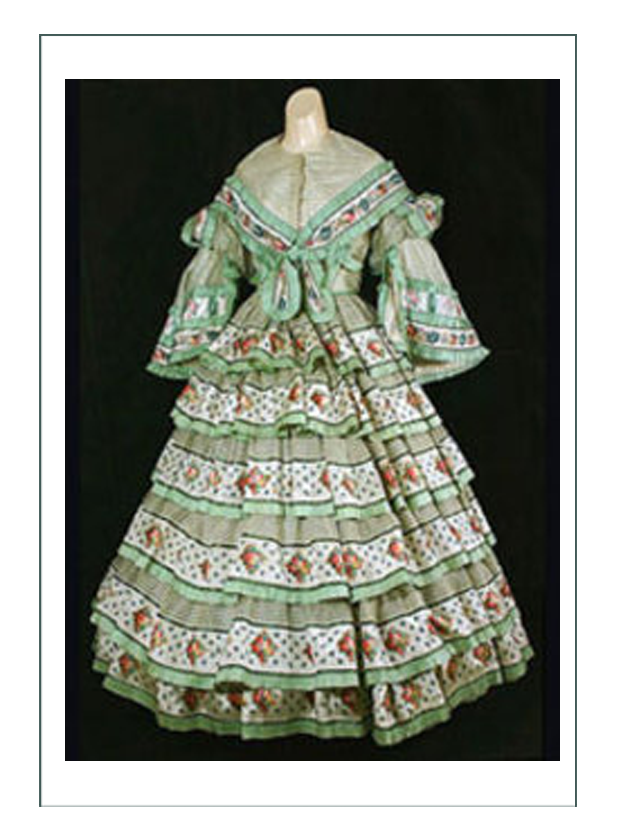
—— (above) “Southern Day Dress 1855” ——
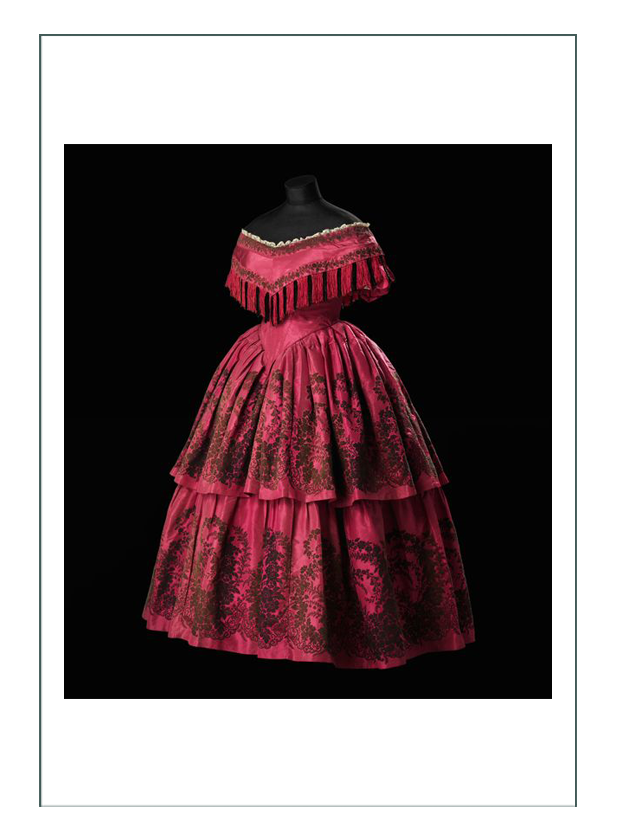
—— (above) “Evening Dress 1859” ——
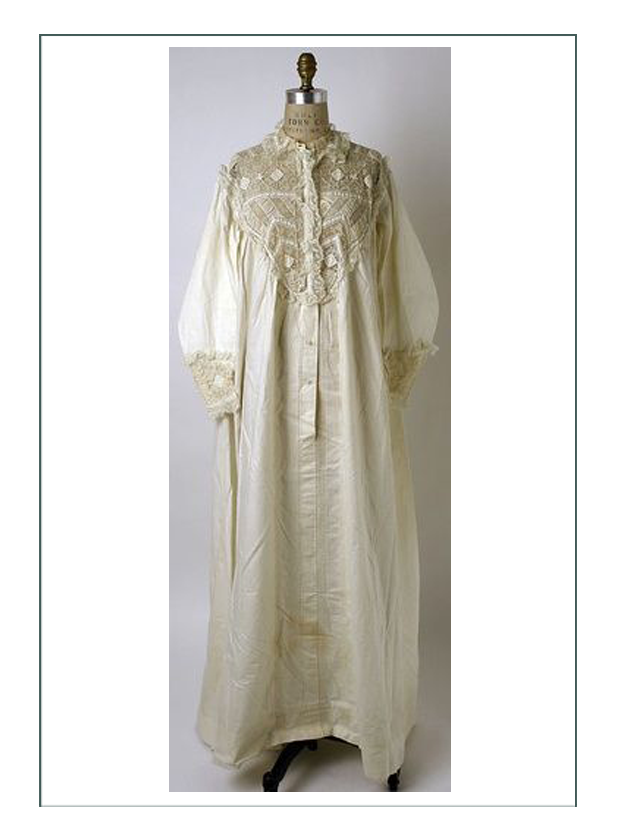
—– (above) “Nightgown 1860’s” ——
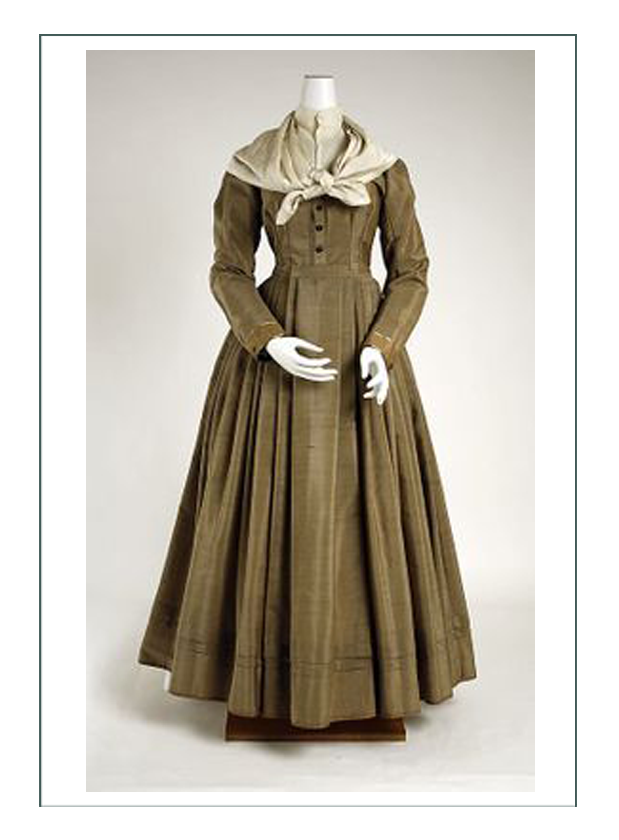
—— (above) “Hired Help or Casual Dress 1860” ——
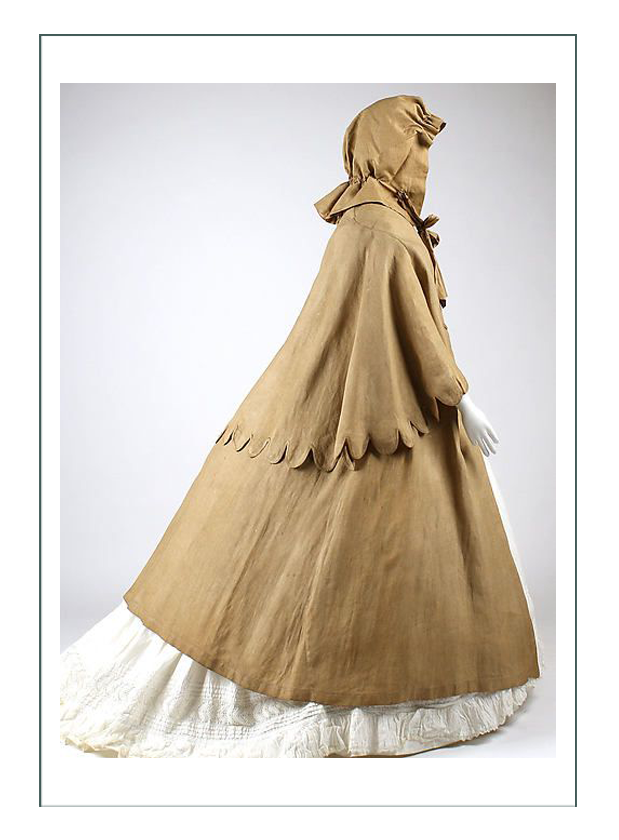
—– (above) “Linen Duster 1860” ——
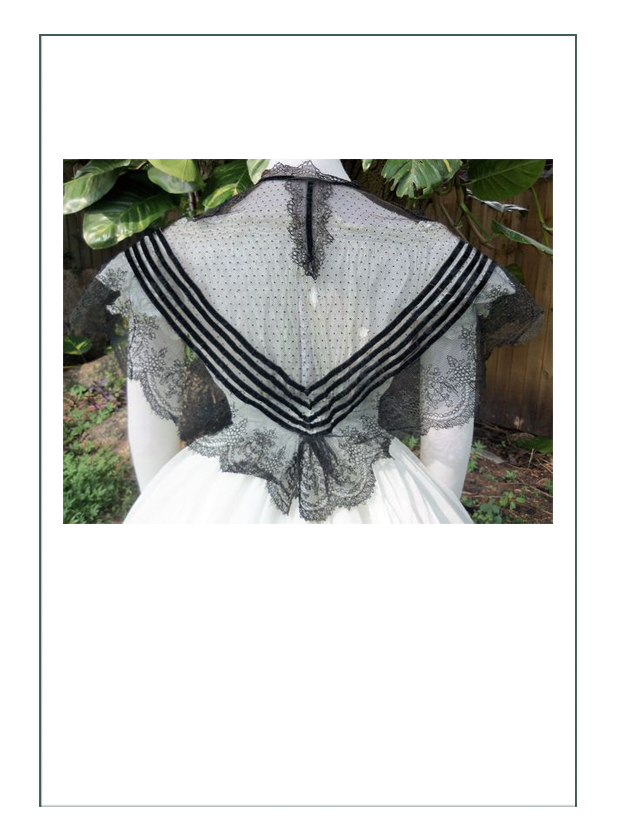
—– (above) “French Lace Fichu 1860” ——
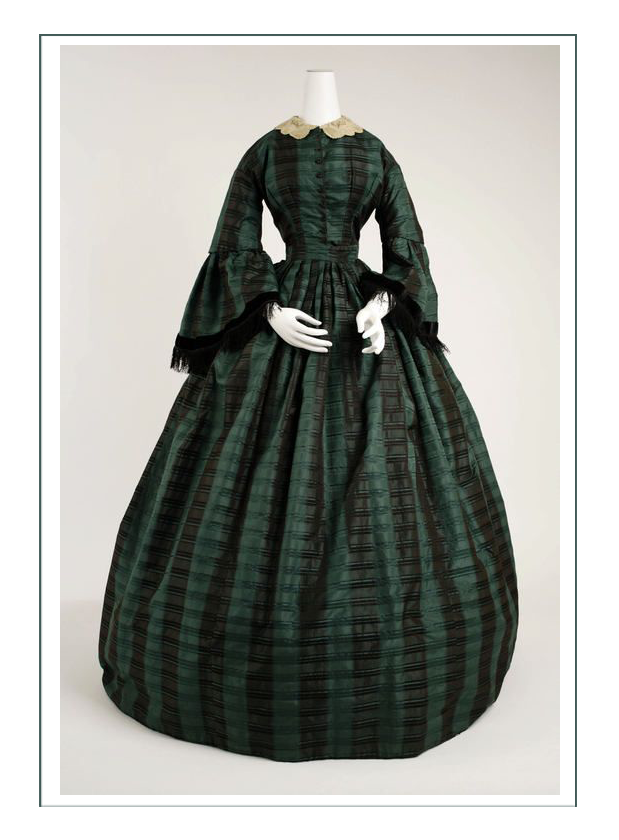
—– (above) “American Made Day Dress 1860” ——
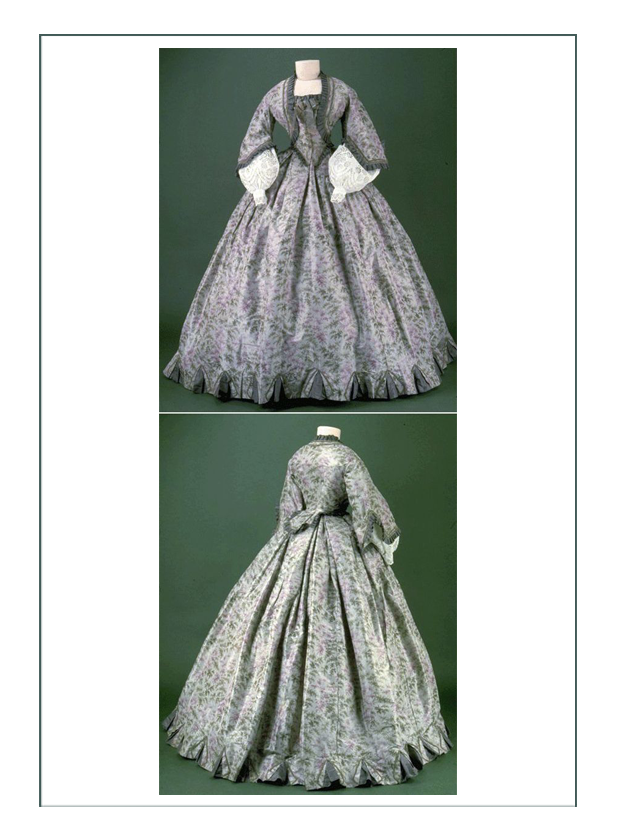
—— (above) “Northern Day Dress 1862” ——
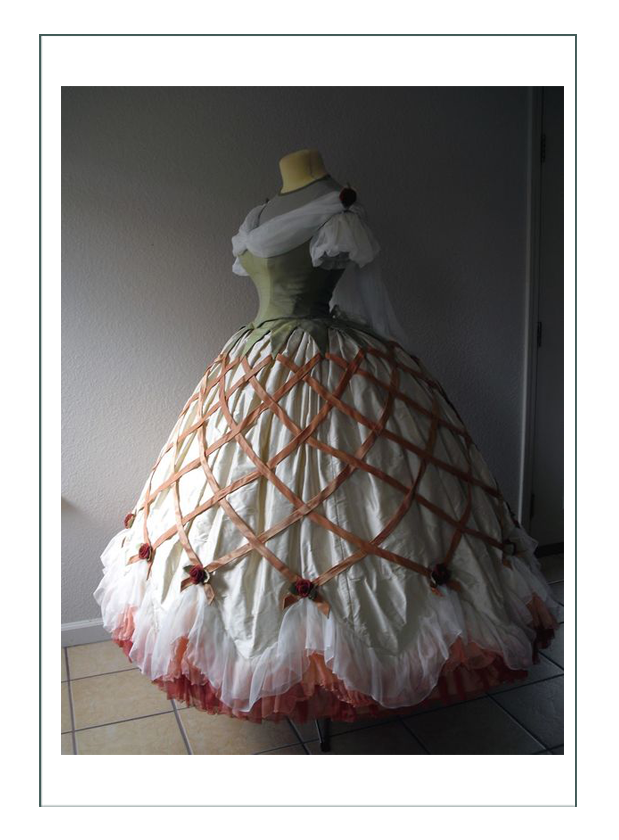
—— (above) ” Doll Cake Ball Gown 1862——
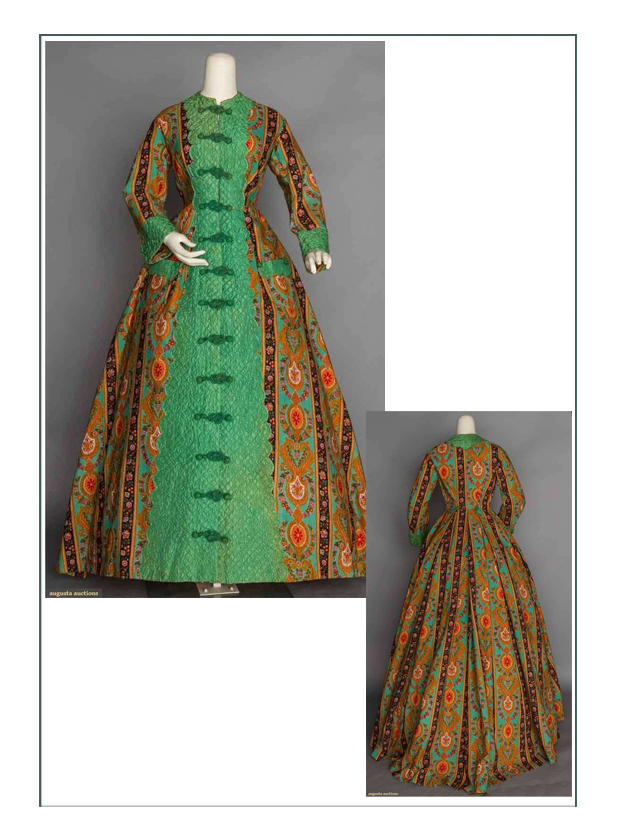
—– (above) “Wool Wrapper 1863” ——
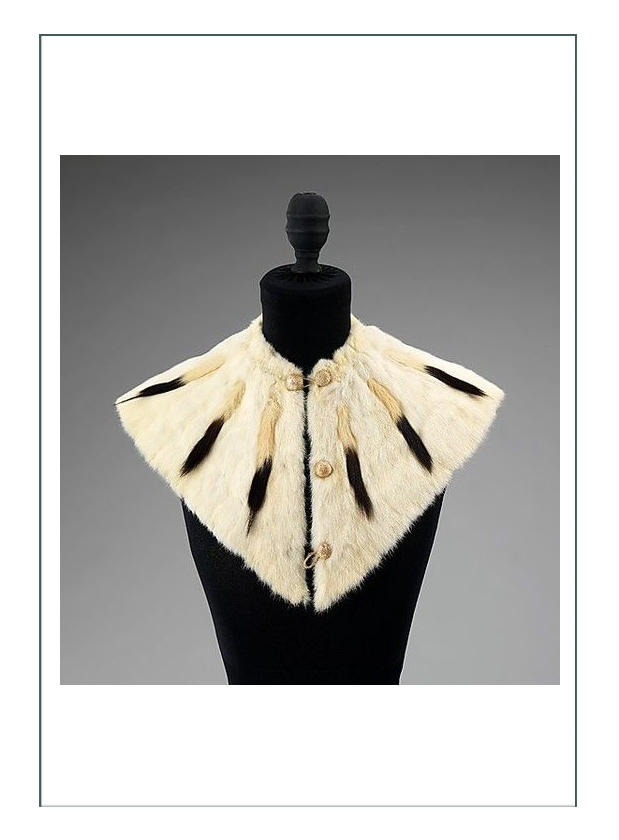
—– (above) “Ermine Tippet 1862” ——
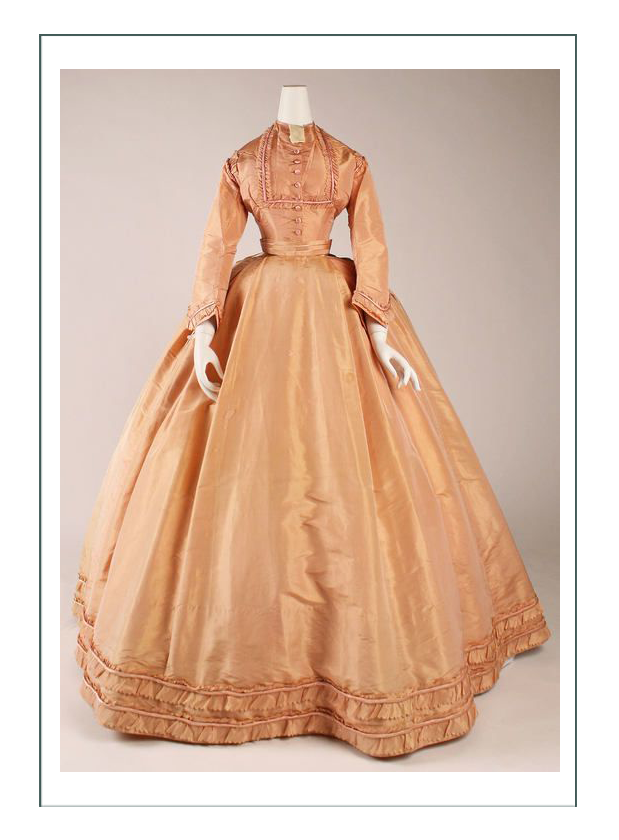
(above) “Silk Town Dress 1864-65” ——
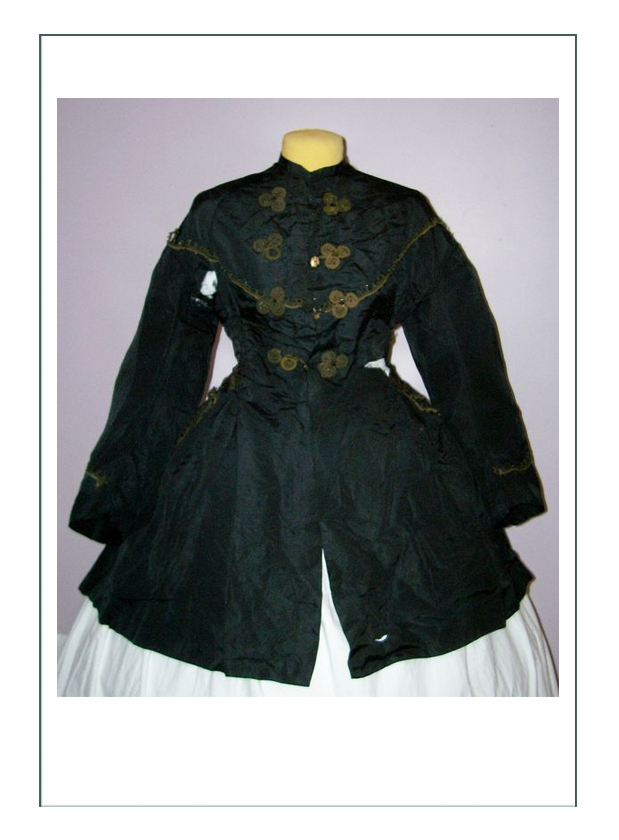
—– (above) “Carriage Jacket 1865” ——
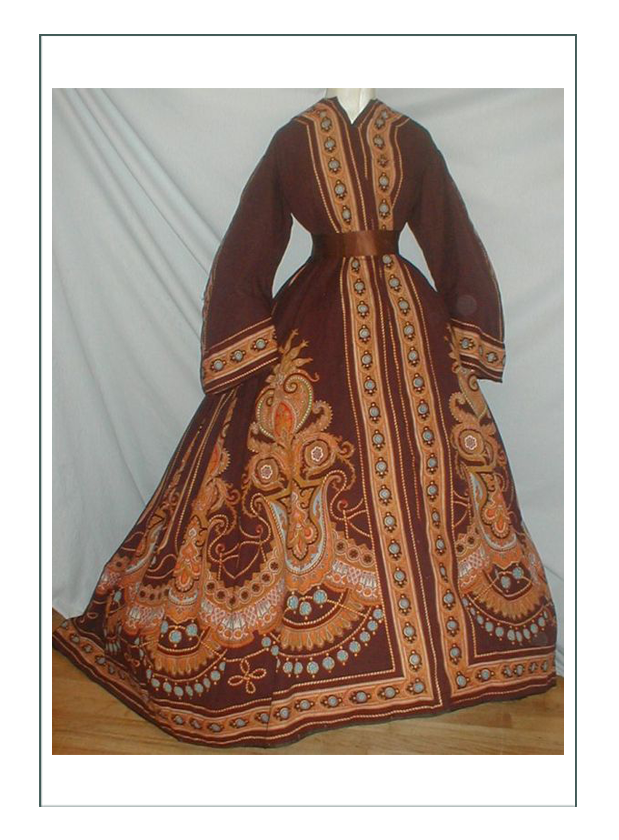
—– (above) “Paisley Wrapper 1866” ——
Click date below to go to a different era. We can replicate most ANY garment you see!


